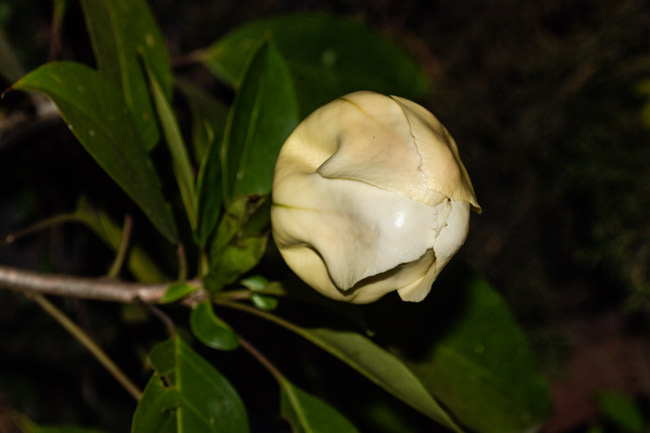Many plants of the family Solonaceae flower at night: Ipomoea alba is one; Solandra maxima, cup of gold is another. There are so many flowers of Guatemala that bloom at night. Many are vines, many are cactus.
We are interested in finishing our list of all night blooming flowers, and then finding the eco-system where each grows, learning in which month they flower, and then having our team of photographers with specialized equipment and lots of experience doing stop-action sequences to record these flowers as they bloom.
The photos here are taken without outside funding, so are just sample photos with a Nikon D810 and Nikon D5. It is always good to have more than one camera aimed at a flower-as-it-blooms.
Which pollinators work at night?
Aristoloca is potentially the tallest flower of Guatemala. Datura and Brugmansia are fairly long but Brugmansia is not native to the Mayan or Aztec areas.
For width, I estimate that the flowers of Solandra maxima are in the top for sure (and probably in the Top) flower sizes of Guatemala. I have not yet seen a flower this wide in Guatemala (Brugmasia flowers can be wide but they are not native). Datura are rarely cultivated in gardens so I have no measurements for their flower width.
I am using the name Solandra maxima; if a botanist indicates this is a synonym or is otherwise incorrect, we appreciate corrections.
Flowers of Solandra maxima sort of wilt during full sun
The flowers are in full bloom in the early morning. Where the plant is growing it takes several hours for the sun to find a path to shine through all the trees: during the hours that the sun is directly on the flower, it literally wilts.
Then when the full sun is gone, the flower returns to full open position (fully horizontal). The flowers stay open about three or four days (today is the second day in full bloom: the flower opened Sunday night and was blooming all day Monday and will bloom all day today (Tuesday). It will wilt in a few hours and then return to full bloom when the sun shifts away.
Solandra maxima Cup of gold vine Sunday at 7:01pm flower starts to open on March 11,2018. Photo taken by Dr Nicholas Hellmuth.
We noticed no odor, and no pollinators of the flower of Solandra maxima
I came out to photograph the opening of the flower every several minutes (after it was fully open). During the one hour opening process I was there half the time (FLAAR has capable photography assistants who can take photos of time lapse on their own).
During the entire time I was there, not one hint of any odor whatsoever. Yet we have other plants in our garden that lure you with their enticing fragrance. Zilch for the cup of gold flower. Maybe it is later at night that the chemicals get active? On the second night, at about 9:30 pm, not one iota of fragrance positive or negative odor whatsoever. Even with my nose 20 cm from the flower: nothing whatsoever.
Before the flower opened there were occasionally insects the size of really tiny ants on the bud. But I saw no pollinators the first hour it was open. Of course our studio lights and the flash of the two cameras could easily have scared pollinators away.
For further information on Solandra maxima, cup of gold, Ratsch is available
Even though I was a student at Harvard in the 1960s, I do not eat, drink, or smoke Solandra maxima, or Dactura, or Cecropia leaves.
Even though I visited Palenque frequently in the 1960s and 1970s, I do not eat, drink, or smoke mushrooms that were infamous for Palenque in those years.
It's not that I am a prude, it's that there is so much to learn about in life, especially the plants, animals, flowers, pollinators, reptiles, fish, birds of the Mayan areas that I prefer to do research and field trips so that I can understand, for example, how to recognize a wasp that makes honey.
Besides, there are plenty of capable scholars who are experienced with plants such as Solandra maxima. The book and articles by Christian Rätsch are an example. He devotes two large pages to Solandra species (2005: 473-476).
Plants of the Solanaceae family (Nightshade family) vary from toxic to hallucinogenic
Yet potatoes and tomatoes are also of the Solanaceae family. And one of the common garden flowers in Mesoamerica, Brugmansia, is also of the family Solanaceae (but best not even to breathe too much Brugmansia scent). Brugmansia is not native to Guatemala but is popular in gardens because it is so easy and fast to grow and flower.
Plus Solanum wendlandii is stated to be edible by local Q'eqchi' Mayan people. The vines we have in our office in Guatemala City come from gardens in Cahabon, Alta Verapaz. Here and in many other areas Solanum wendlandii is a common garden plant. I estimate that not many people eat it, even though they know Quixtán is edible.
So for plants of the Mayan world you do not need to focus on Solandra maxima. But it is definitely interesting to try to figure out when the bud will burst into bloom. I estimate that the precise hour will depend a bit on weather, but 7 pm was when the flower started (finally, after we had cameras set up THREE DAYS).
Mayan culture did indeed use many of the same happy plants that the Aztec and prehispanic people all over Mexico used (surely the Greeks, Romans and everywhere else also figured out what plants could get them happy too). But I prefer to be able to watch the petals or sepals of a flower getting ready to spring into action to open.
Solandra maxima at 8:26 am flower opens on March 12,2018. Photo taken by Dr Nicholas Hellmuth.
First Posted March 13, 2018.















































































